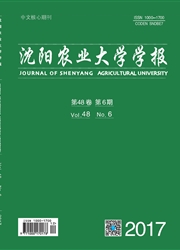

 中文摘要:
中文摘要:
为了深入剖析水稻粒形性状的遗传调控机理,以典型籼稻品种七山占(Qishanzhan)和典型粳稻品种秋光(Akihikari)为亲本构建的重组自交系群体为材料,于2011-2013年分别对各株系的粒长、粒宽和粒厚3个粒形性状进行表型测定,并基于完备区间作图法(ICIM)进行粒形性状基因定位研究。试验结果表明:共检测到27个控制粒形性状的QTLs,包括3个粒长QTLs,11个粒宽QTLs和13个粒厚QTLs,它们分布于第1,2,3,4,5,11和12号染色体上,可分别解释14.45%-38.48%,28.98%-52.36%和38.77%-44.23%的表型变异;进一步分析发现,在第3,5和12号染色体上检测到的粒形性状QTL位点较多,且呈簇分布;此外,检测到q GL12a,q GL12b,q GW1,q GW5a,q GT11a和q GT12b等6个较新的QTLs位点,其中控制粒宽的q GW5a连续3年表达稳定,是一个重演性极好的QTL位点。以上结果将为水稻粒形性状的QTL克隆和遗传改良奠定基础。
 英文摘要:
英文摘要:
To analyze the genetic regulation mechanism of rice grain type traits, recombinant inbred lines(RILs) derived from a cross between Akihikari(typical japonica variety)/Qishanzhan(typical indica variety) were used to map QTL controlling seed shape(grain length, grain width and grain thickness) from 2011 to 2013 based on Inclusive Composite Interval Mapping(ICIM) method. A total of 27 QTLs were detected containing 3 QTLs for grain length, 11 QTLs for grain width and 13 QTLs for grain thickness, which were identified on chromosomes 1, 2, 3, 4, 5, 11 and 12 and accounted for 14.45%-38.48%, 28.98%-52.36% and 38.77%-44.23% phenotypic variation, respectively. Further analysis showed that three QTLs clusters were detected on chromosome 3, 5 and 12. In addition, six relatively new QTLs were found, such as q GL12 a, q GL12 b, q GW1, q GW5 a, q GT11 a and q GT12 b, and q GW5 a is one of good reproducibility QTL which controlling grain width,in three years. These conclusions would be the basis to the future research of QTL clone and molecular genetic improvement for rice grain shape.
 同期刊论文项目
同期刊论文项目
 同项目期刊论文
同项目期刊论文
 期刊信息
期刊信息
